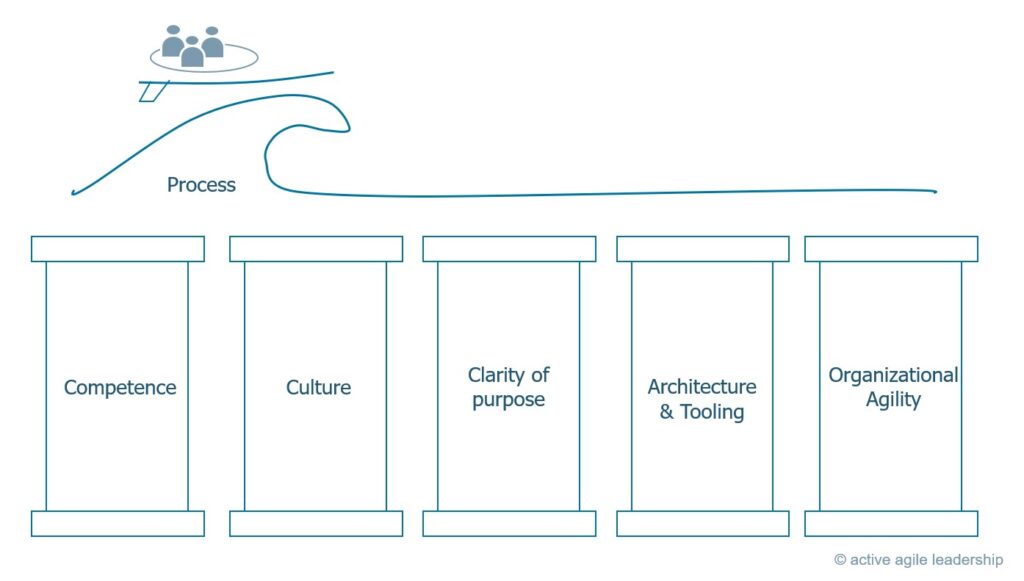“The right process will produce the right result”. This has long been the mantra explaining why the focus should not be on the hard working individual, but rather on the process which they work in. While there is some truth to the statement, it also has some serious blind spots. It’s time to put this kind of thinking to rest.
The trouble with the statement is the limited perspective it induces. This often carries over to the way Agile very easily gets implemented, by putting a process in place. Yes, you need a process, but the smart companies in the digital age realize that the process itself is not the end goal, but an awesome product experience, speed and engaged responsible people are.
Smart companies realize that a process can do no better than the system/environment in which they are run. If a process gets in the way of thinking people, it should be dismantled and improved. Remember the Agile manifesto: “People over process”?
Others have realized this as well:
“I don’t believe in process. In fact, when I interview a potential employee and if he or she says ‘it’s all about the process,’ I see that as a bad sign. The problem is that, at a lot of big companies, process becomes a substitute for thinking. You’re encouraged to behave like a little gear in a complex machine. Frankly, it allows you to keep people who aren’t that smart, who aren’t that creative.”
Elon Musk, Wired, October 2012
No tool is better than the hand that holds it
The hidden side effect of running an Agile transformation primarily through implementing a process is that it doesn’t challenge much of the thinking that underpins how operations are currently run.
You will get a few improvements through a refined process, continuous improvement in a few isolated cases, but a sustainable competitive edge? No. The reason is simple, you are merely copying what others do, you aren’t really innovating.
Test it yourself: When was the last time your company removed or simplified a corporate process or policy? If this hasn’t happened, you are simply stacking on more things on busy people’s schedules, confusing working hard with working smart.
At Active Agile, process is the result of your system. Long term leadership is about growing the system/environment where teams thrive. You can call this our key underlying assumption.
If the system is built well, it can be lean and easy to adapt. If the system is poorly built, the process needed to harness it becomes “fat”. When this happens, you get ripple effects – the “fat” process becomes hard to maintain.
It gets on top of its organizational bodies (for example: steering committees, process offices) which have to be created just to uphold them. Suddenly you have sustained accidental complexity and this is how you unwittingly set up the organization for compliance to process that you never wanted in the first place, rather than for rapid continuous improvement.
5 system/environment capabilities illustrated
So what are the system/environment capabilities you need to work with long term, to reduce process overhead and inadvertent organizational complexity? At Active Agile we highlight five capabilities:

All models are in some shape or form simplified assumptions. So is this. But it can also provide a basis for understanding and clues as to what to look for. Let’s entertain the thought for a moment, and elaborate a few simple rationales for each system capability:
Competence
The right competence is key to success. Competence and skill also dictate how much trust is usually granted.
Culture
Culture eats process for breakfast. Two of the mindsets that enable learning are an experimental mindset (give it a try, and quick) and a growth mindset (there are more than one way to solve the problem). Contrast that with the fixed mindset, “this is the best way”.
Clarity of purpose
What is the direction? Is it meaningful, and realistic? A shared sense of purpose and clarity of direction is the key to enabling autonomy.
Architecture and tooling
Architecture, automation and tooling hold critical keys to our everyday work. Complex architecture drives the need for a complex process, and also the need for a complex organization. So the better approach is to simplify them. Make them user-friendly, adaptable and automate away repetitive tasks. This frees up mental bandwidth for humans to focus on the critical problems instead of fire fighting.
Organizational Agility
The organization we setup impacts all of the above factors. If we set it up correctly from the start, it also enables us to grow quickly while keeping fast feedback loops with customers we are there to delight.
The right system produces the right result
Long term leadership is the dedication and determination to invest in your people and the environment they work in, for the long haul, in order to build hard-to-copy competitive edge when it comes to awesome product experience, speed and employee engagement.

How true. We must recognise that a good result may seem to come a good process. But the process exists only in a context of culture, architecture, organisation and more.